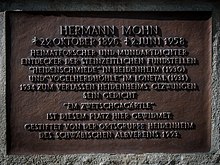Hermann Mohn
Hermann David Mohn (born October 29, 1896 in Heidenheim an der Brenz , † June 2, 1958 in Erfurt ) was a Swabian dialect poet and local researcher . He was the discoverer of the Stone Age sites Heidenschmiede in Heidenheim and the Vogelherd cave near Stetten ob Lontal .
Life
Origin and family
Mohn was the son of City Councilor Friedrich Mohn and his wife Pauline Johanna Mohn, née Siegmann, and grew up in Heidenheim. After completion of the intermediate certificate and an education in the central railway service he was in the First World War as a radio operator used.
In May 1921 he married Frida Huck, who came from Bad Mergentheim , and their daughter Erika was born on July 30, 1922.
Local history
In addition to his work as Reichsbahn secretary , Mohn was active as a local researcher and discovered the Heidenschmiede during his explorations in the summer of 1928, an abri in the rock massif below Hellenstein Castle , which he completely excavated two years later .
On 23 May 1931 he was in the excavation in front of a badger at Vogelherd in the Lone Valley several Absplisse from flint and informed here about the prehistory Gustav Riek , who uncovered the then completely backfilled Vogelherd cave in the port and archaeologically investigated.
At the beginning of June 1932 Mohn discovered the Bear Rock Grotto on the north side of the Bruckersberg in Giengen an der Brenz . During a trial cut , it was able to recover more than a hundred Upper Paleolithic artifacts at a depth of about 2 meters .
Political attitude and exile
Mohn was an avowed democrat and pacifist , volunteered in local associations, was a member of the German Peace Society and a board member and state parliament candidate of the German Democratic Party . In addition to his dialect poems and children's stories, he published anti-fascist articles in local newspapers and worked for the political magazine Das Andere Deutschland .
At the instigation of the NSDAP he was transferred to Zeitz in Thuringia on May 15, 1934 , and he was forbidden to return to Heidenheim for life. In the following years he was monitored, interrogated and threatened several times by the NSDAP security service. In 1937 Mohn joined the NSDAP because he hoped that this would improve his situation, but this did not materialize: an upcoming professional promotion was suspended and in July 1941 he was transferred to Minsk without a family . At the beginning of 1944 he was transferred to Brest-Litowsk , from where he was able to return to Erfurt in the summer of the same year for health reasons.
rehabilitation
After the end of World War II , Mohn's openly anti-fascist stance and his longstanding membership in the anti-Nazi cell of the Reichsbahndirektion Erfurt were confirmed from various sides. As early as July 1, 1945, he was professionally rehabilitated and appointed first traffic controller at the Reichsbahnverkehramt in Erfurt.
Hermann Mohn died on June 2, 1958 in Erfurt, his urn was buried in the Totenbergfriedhof in Heidenheim the following month.
Honors
In December 1979, Hansjürgen Müller-Beck , then head of the Institute for Prehistory and Protohistory at the Eberhard Karls University in Tübingen , honored Mohn's research- historical achievements towards his widow and daughter in Heidenheim.
In February 1990 the town council of Heidenheim decided to name a footpath after Mohn. The Hermann-Mohn-Weg leads from the former home of the Mohn family in Schlossstrasse via the Zwetschgagärtle to Hellenstein Castle and the Heidenschmiede to Im Flügel .
The adventure footpath leading from the information center of Archäopark Vogelherd to the Vogelherd cave is named Hermann-Mohn-Rundweg in his honor .
Publications
- Em Zwetschgagartle . Self-published, Heidenheim 1929
Individual evidence
- ↑ Eduard Peters: The Heidenschmiede in Heidenheim . E. Schweizerbart'sche Verlagbuchhandlung (Erwin Nägele), Stuttgart 1931.
- ↑ a b c Ulrich Huber: Who was Hermann Mohn? Self-published, Heidenheim an der Brenz 2010 (first edition: 1989).
- ↑ Jens Eber: Commemoration: The grave of local history researcher Mohn has been cleared. In: Heidenheimer Zeitung . January 21, 2016, accessed June 4, 2019 .
- ↑ Personal files (Bü 33023) in the holdings K 410 I (Reichs- / Bundesbahndirektion Stuttgart: Personal files of the railway officials) in the State Archives in Ludwigsburg
- ^ Gustav Riek: Three Upper Palaeolithic stations on the Bruckersberg in Giengen an der Brenz . Silberburg Kommissionsverlag, Stuttgart 1957.
- ↑ Vogelherd Archaeological Park. The park. Hermann-Mohn-Rundweg , accessed on March 2, 2014
| personal data | |
|---|---|
| SURNAME | Poppy, Hermann |
| ALTERNATIVE NAMES | Mohn, Hermann David (full name) |
| BRIEF DESCRIPTION | German dialect poet and local researcher |
| DATE OF BIRTH | October 29, 1896 |
| PLACE OF BIRTH | Heidenheim an der Brenz |
| DATE OF DEATH | June 2, 1958 |
| Place of death | Erfurt |

